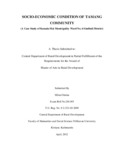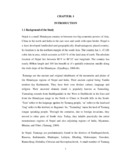Please use this identifier to cite or link to this item:
https://elibrary.tucl.edu.np/handle/123456789/2358| Title: | Socio-Economic Condition of Tamang Community (A Case Study of Kamala Mai Municipality Ward No. 6 Sindhuli District |
| Authors: | Ghalan, Milan |
| Keywords: | Socio-economic condition;Tamang Community;Sindhuli |
| Issue Date: | Apr-2012 |
| Publisher: | Central Department of Rural Development Tribhuvan University, Kathmandu |
| Abstract: | This is a study entitled, “Socio-Economic Condition of Tamang Community (A Case Study of Kamala Mai Municipality Ward No. 6 Sindhuli District. The general objective of this study is to analyze socio-economic conditions of the Tamang community of the study area and the specific objectives are to find out a socio economic status, cultural status Tamang and to suggest measures for the improvement in their status This study has been based on descriptive as well as exploratory research design which is considered as appropriate and the best for the analysis of this type of research study. It has been adopted exploratory because it makes attempt to explore the process of the study site. This study is limited only with 50 households, which is the small part of the whole Tamang community of Nepal. It has been based on both primary and secondary data. Primary data have been collected through household survey questions (interview), observation, group discussion and key informant etc. Similarly secondary data have been collected through published and unpublished materials such as research articles, related books, CBS report, previous studies and related profiles. The information related to socio economic status of Tamangs which was collected from group discussion. The information was help to fulfill the objective of the study. It will focus on Socio-economic condition of Tamangs’s, main festivals, educational condition and major problems of Tamangs. The old village people, school teachers, village head man have knowledge about the Tamangs of the study area they were selected as key informants and information has been collected through interview. Collected data has been presented and analyze by using simple statistical and mathematical tools Statistical tools such as percentage, diagram and table etc. |
| URI: | http://elibrary.tucl.edu.np/handle/123456789/2358 |
| Appears in Collections: | Rural Development |
Files in This Item:
| File | Description | Size | Format | |
|---|---|---|---|---|
| Cover.pdf | 403.48 kB | Adobe PDF |  View/Open | |
| Thesis.pdf | 1.46 MB | Adobe PDF |  View/Open |
Items in DSpace are protected by copyright, with all rights reserved, unless otherwise indicated.
